Legal Analysis: Negligent Misstatement by Dandenong Council Case
VerifiedAdded on 2022/11/14
|5
|1308
|424
Case Study
AI Summary
This case study examines whether Jack Smith can sue Dandenong Council for negligent misstatement resulting in economic loss. The issue revolves around a road widening proposal that was not disclosed in a council certificate, impacting Smith's land development plans. The analysis applies the tort of negligent misstatement, focusing on the duty of care owed by the council and the foreseeability of the economic loss. The case references key legal precedents such as Hedley Byrne v Heller, Sutherland Shire Council v Heyman, and Donoghue v Stevenson. The conclusion suggests that while Dandenong Council could be liable for pure economic loss due to negligence, Smith's claim may be unsuccessful if he did not rely on the council's certificate before purchasing the land. The case study highlights the importance of establishing a duty of care and the reliance on information provided by authorities in cases of negligent misstatement.
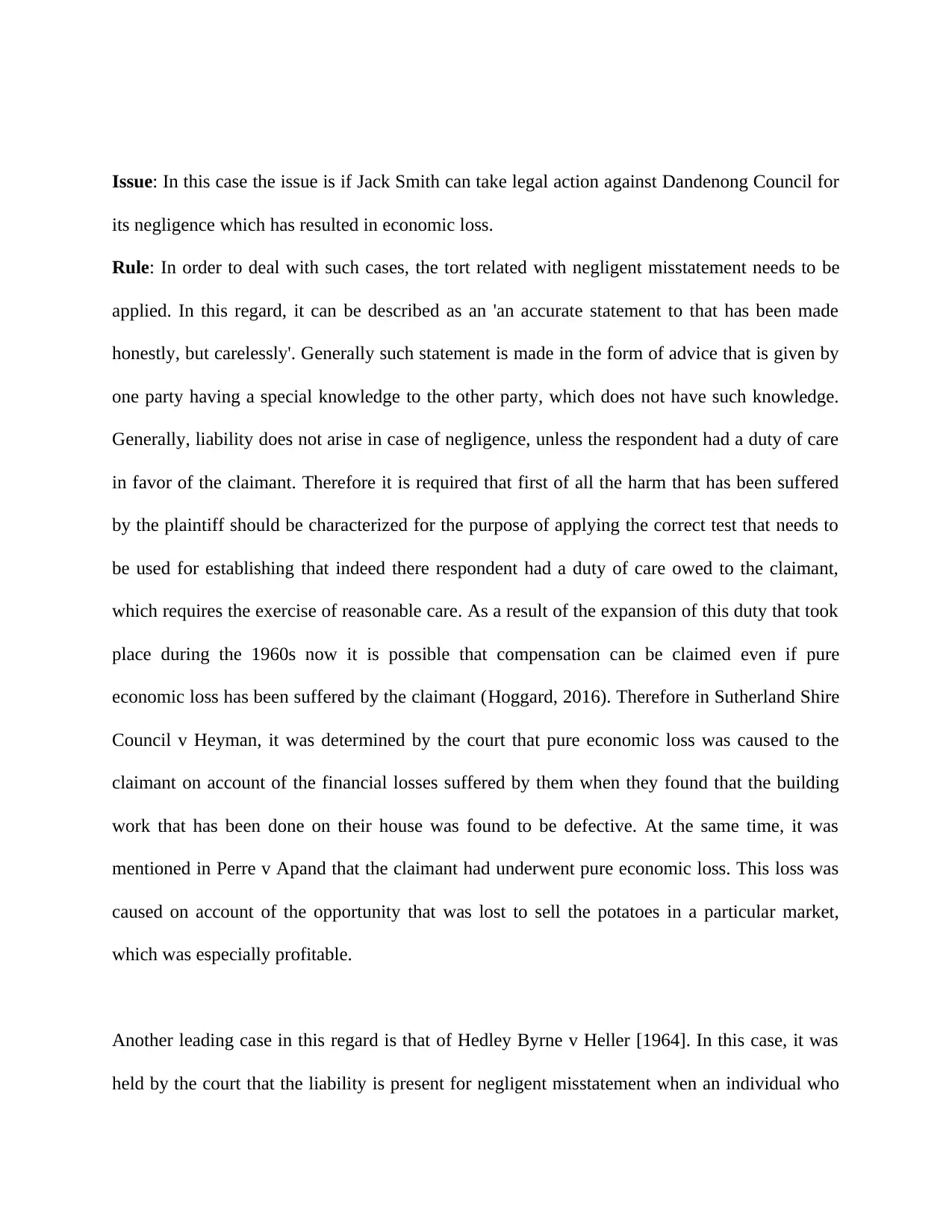
Issue: In this case the issue is if Jack Smith can take legal action against Dandenong Council for
its negligence which has resulted in economic loss.
Rule: In order to deal with such cases, the tort related with negligent misstatement needs to be
applied. In this regard, it can be described as an 'an accurate statement to that has been made
honestly, but carelessly'. Generally such statement is made in the form of advice that is given by
one party having a special knowledge to the other party, which does not have such knowledge.
Generally, liability does not arise in case of negligence, unless the respondent had a duty of care
in favor of the claimant. Therefore it is required that first of all the harm that has been suffered
by the plaintiff should be characterized for the purpose of applying the correct test that needs to
be used for establishing that indeed there respondent had a duty of care owed to the claimant,
which requires the exercise of reasonable care. As a result of the expansion of this duty that took
place during the 1960s now it is possible that compensation can be claimed even if pure
economic loss has been suffered by the claimant (Hoggard, 2016). Therefore in Sutherland Shire
Council v Heyman, it was determined by the court that pure economic loss was caused to the
claimant on account of the financial losses suffered by them when they found that the building
work that has been done on their house was found to be defective. At the same time, it was
mentioned in Perre v Apand that the claimant had underwent pure economic loss. This loss was
caused on account of the opportunity that was lost to sell the potatoes in a particular market,
which was especially profitable.
Another leading case in this regard is that of Hedley Byrne v Heller [1964]. In this case, it was
held by the court that the liability is present for negligent misstatement when an individual who
its negligence which has resulted in economic loss.
Rule: In order to deal with such cases, the tort related with negligent misstatement needs to be
applied. In this regard, it can be described as an 'an accurate statement to that has been made
honestly, but carelessly'. Generally such statement is made in the form of advice that is given by
one party having a special knowledge to the other party, which does not have such knowledge.
Generally, liability does not arise in case of negligence, unless the respondent had a duty of care
in favor of the claimant. Therefore it is required that first of all the harm that has been suffered
by the plaintiff should be characterized for the purpose of applying the correct test that needs to
be used for establishing that indeed there respondent had a duty of care owed to the claimant,
which requires the exercise of reasonable care. As a result of the expansion of this duty that took
place during the 1960s now it is possible that compensation can be claimed even if pure
economic loss has been suffered by the claimant (Hoggard, 2016). Therefore in Sutherland Shire
Council v Heyman, it was determined by the court that pure economic loss was caused to the
claimant on account of the financial losses suffered by them when they found that the building
work that has been done on their house was found to be defective. At the same time, it was
mentioned in Perre v Apand that the claimant had underwent pure economic loss. This loss was
caused on account of the opportunity that was lost to sell the potatoes in a particular market,
which was especially profitable.
Another leading case in this regard is that of Hedley Byrne v Heller [1964]. In this case, it was
held by the court that the liability is present for negligent misstatement when an individual who
Paraphrase This Document
Need a fresh take? Get an instant paraphrase of this document with our AI Paraphraser
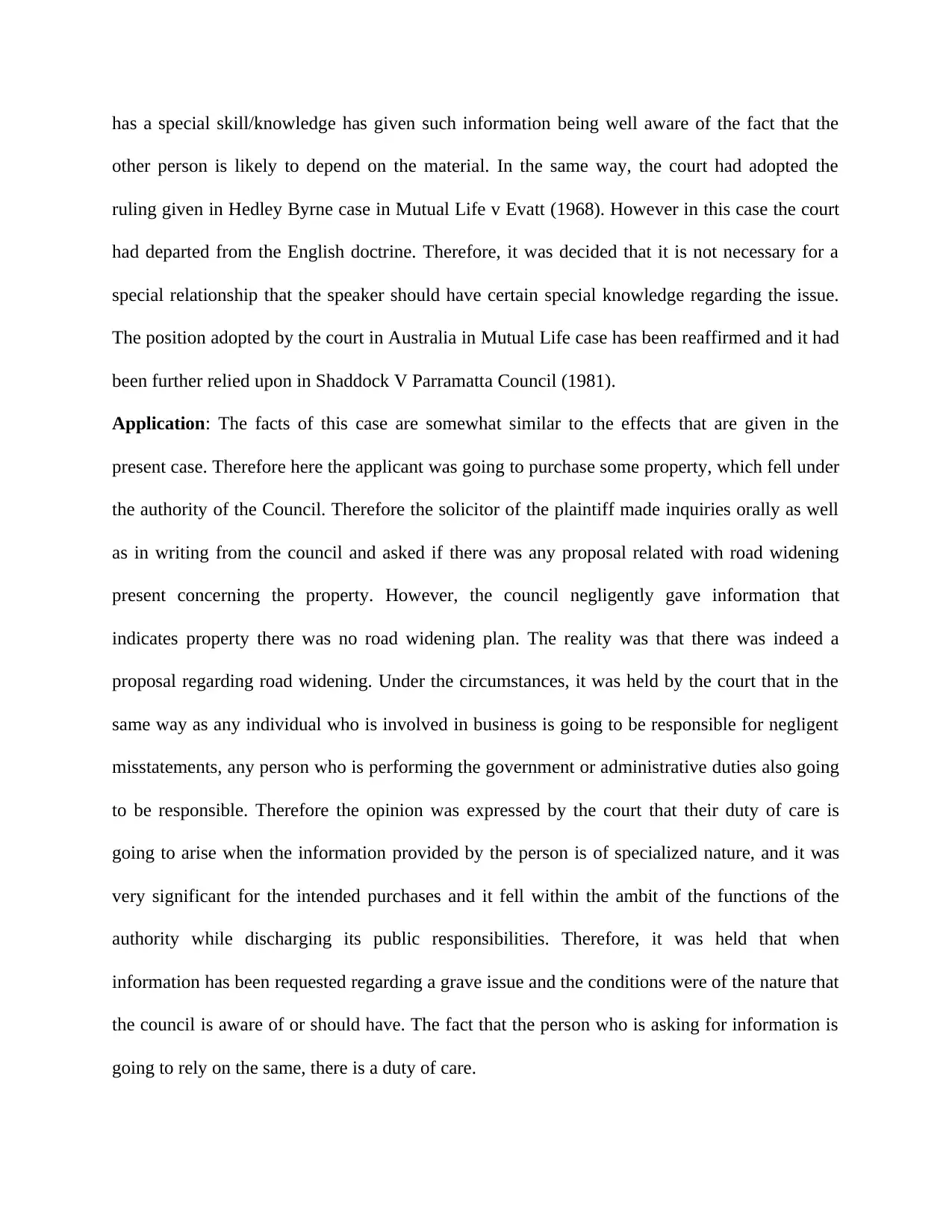
has a special skill/knowledge has given such information being well aware of the fact that the
other person is likely to depend on the material. In the same way, the court had adopted the
ruling given in Hedley Byrne case in Mutual Life v Evatt (1968). However in this case the court
had departed from the English doctrine. Therefore, it was decided that it is not necessary for a
special relationship that the speaker should have certain special knowledge regarding the issue.
The position adopted by the court in Australia in Mutual Life case has been reaffirmed and it had
been further relied upon in Shaddock V Parramatta Council (1981).
Application: The facts of this case are somewhat similar to the effects that are given in the
present case. Therefore here the applicant was going to purchase some property, which fell under
the authority of the Council. Therefore the solicitor of the plaintiff made inquiries orally as well
as in writing from the council and asked if there was any proposal related with road widening
present concerning the property. However, the council negligently gave information that
indicates property there was no road widening plan. The reality was that there was indeed a
proposal regarding road widening. Under the circumstances, it was held by the court that in the
same way as any individual who is involved in business is going to be responsible for negligent
misstatements, any person who is performing the government or administrative duties also going
to be responsible. Therefore the opinion was expressed by the court that their duty of care is
going to arise when the information provided by the person is of specialized nature, and it was
very significant for the intended purchases and it fell within the ambit of the functions of the
authority while discharging its public responsibilities. Therefore, it was held that when
information has been requested regarding a grave issue and the conditions were of the nature that
the council is aware of or should have. The fact that the person who is asking for information is
going to rely on the same, there is a duty of care.
other person is likely to depend on the material. In the same way, the court had adopted the
ruling given in Hedley Byrne case in Mutual Life v Evatt (1968). However in this case the court
had departed from the English doctrine. Therefore, it was decided that it is not necessary for a
special relationship that the speaker should have certain special knowledge regarding the issue.
The position adopted by the court in Australia in Mutual Life case has been reaffirmed and it had
been further relied upon in Shaddock V Parramatta Council (1981).
Application: The facts of this case are somewhat similar to the effects that are given in the
present case. Therefore here the applicant was going to purchase some property, which fell under
the authority of the Council. Therefore the solicitor of the plaintiff made inquiries orally as well
as in writing from the council and asked if there was any proposal related with road widening
present concerning the property. However, the council negligently gave information that
indicates property there was no road widening plan. The reality was that there was indeed a
proposal regarding road widening. Under the circumstances, it was held by the court that in the
same way as any individual who is involved in business is going to be responsible for negligent
misstatements, any person who is performing the government or administrative duties also going
to be responsible. Therefore the opinion was expressed by the court that their duty of care is
going to arise when the information provided by the person is of specialized nature, and it was
very significant for the intended purchases and it fell within the ambit of the functions of the
authority while discharging its public responsibilities. Therefore, it was held that when
information has been requested regarding a grave issue and the conditions were of the nature that
the council is aware of or should have. The fact that the person who is asking for information is
going to rely on the same, there is a duty of care.
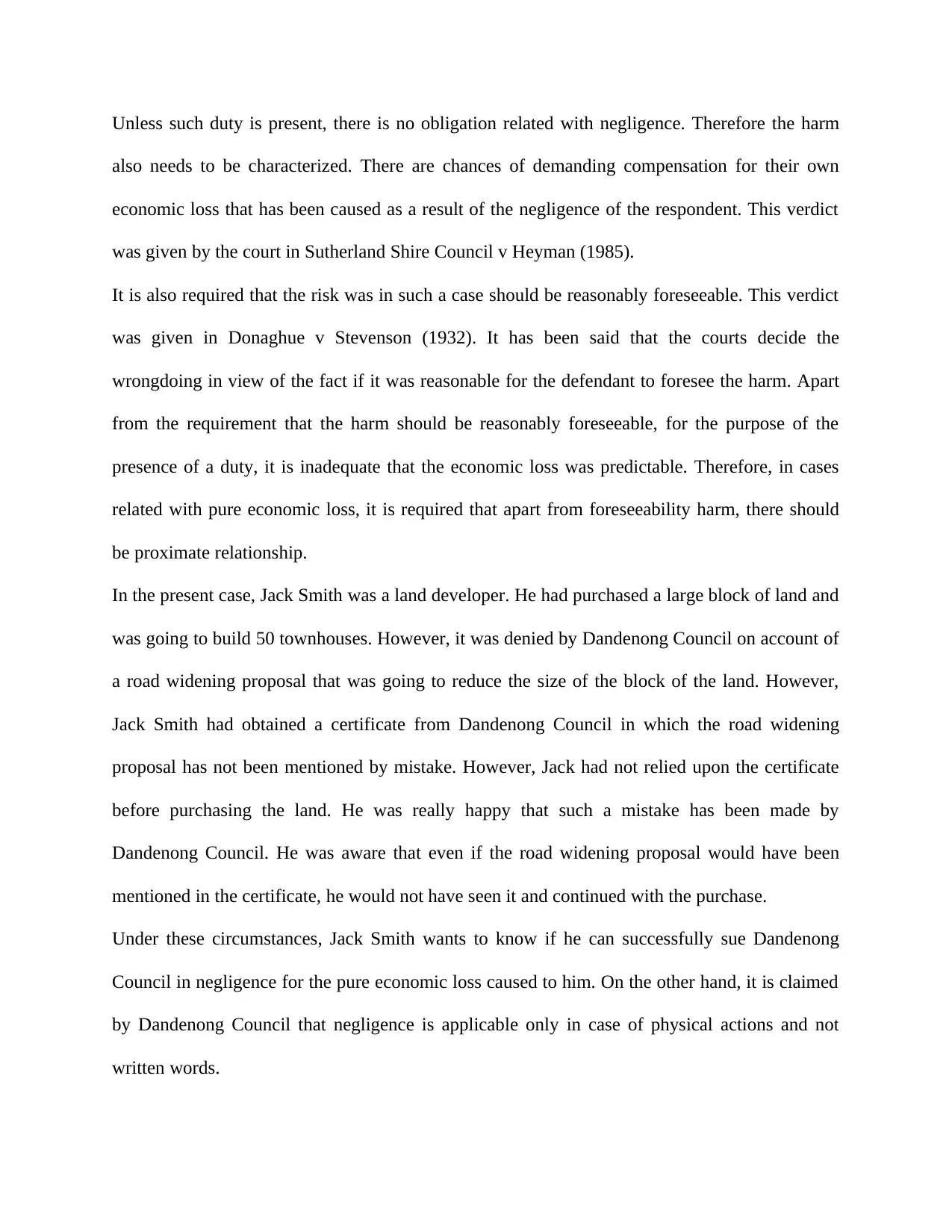
Unless such duty is present, there is no obligation related with negligence. Therefore the harm
also needs to be characterized. There are chances of demanding compensation for their own
economic loss that has been caused as a result of the negligence of the respondent. This verdict
was given by the court in Sutherland Shire Council v Heyman (1985).
It is also required that the risk was in such a case should be reasonably foreseeable. This verdict
was given in Donaghue v Stevenson (1932). It has been said that the courts decide the
wrongdoing in view of the fact if it was reasonable for the defendant to foresee the harm. Apart
from the requirement that the harm should be reasonably foreseeable, for the purpose of the
presence of a duty, it is inadequate that the economic loss was predictable. Therefore, in cases
related with pure economic loss, it is required that apart from foreseeability harm, there should
be proximate relationship.
In the present case, Jack Smith was a land developer. He had purchased a large block of land and
was going to build 50 townhouses. However, it was denied by Dandenong Council on account of
a road widening proposal that was going to reduce the size of the block of the land. However,
Jack Smith had obtained a certificate from Dandenong Council in which the road widening
proposal has not been mentioned by mistake. However, Jack had not relied upon the certificate
before purchasing the land. He was really happy that such a mistake has been made by
Dandenong Council. He was aware that even if the road widening proposal would have been
mentioned in the certificate, he would not have seen it and continued with the purchase.
Under these circumstances, Jack Smith wants to know if he can successfully sue Dandenong
Council in negligence for the pure economic loss caused to him. On the other hand, it is claimed
by Dandenong Council that negligence is applicable only in case of physical actions and not
written words.
also needs to be characterized. There are chances of demanding compensation for their own
economic loss that has been caused as a result of the negligence of the respondent. This verdict
was given by the court in Sutherland Shire Council v Heyman (1985).
It is also required that the risk was in such a case should be reasonably foreseeable. This verdict
was given in Donaghue v Stevenson (1932). It has been said that the courts decide the
wrongdoing in view of the fact if it was reasonable for the defendant to foresee the harm. Apart
from the requirement that the harm should be reasonably foreseeable, for the purpose of the
presence of a duty, it is inadequate that the economic loss was predictable. Therefore, in cases
related with pure economic loss, it is required that apart from foreseeability harm, there should
be proximate relationship.
In the present case, Jack Smith was a land developer. He had purchased a large block of land and
was going to build 50 townhouses. However, it was denied by Dandenong Council on account of
a road widening proposal that was going to reduce the size of the block of the land. However,
Jack Smith had obtained a certificate from Dandenong Council in which the road widening
proposal has not been mentioned by mistake. However, Jack had not relied upon the certificate
before purchasing the land. He was really happy that such a mistake has been made by
Dandenong Council. He was aware that even if the road widening proposal would have been
mentioned in the certificate, he would not have seen it and continued with the purchase.
Under these circumstances, Jack Smith wants to know if he can successfully sue Dandenong
Council in negligence for the pure economic loss caused to him. On the other hand, it is claimed
by Dandenong Council that negligence is applicable only in case of physical actions and not
written words.
⊘ This is a preview!⊘
Do you want full access?
Subscribe today to unlock all pages.

Trusted by 1+ million students worldwide
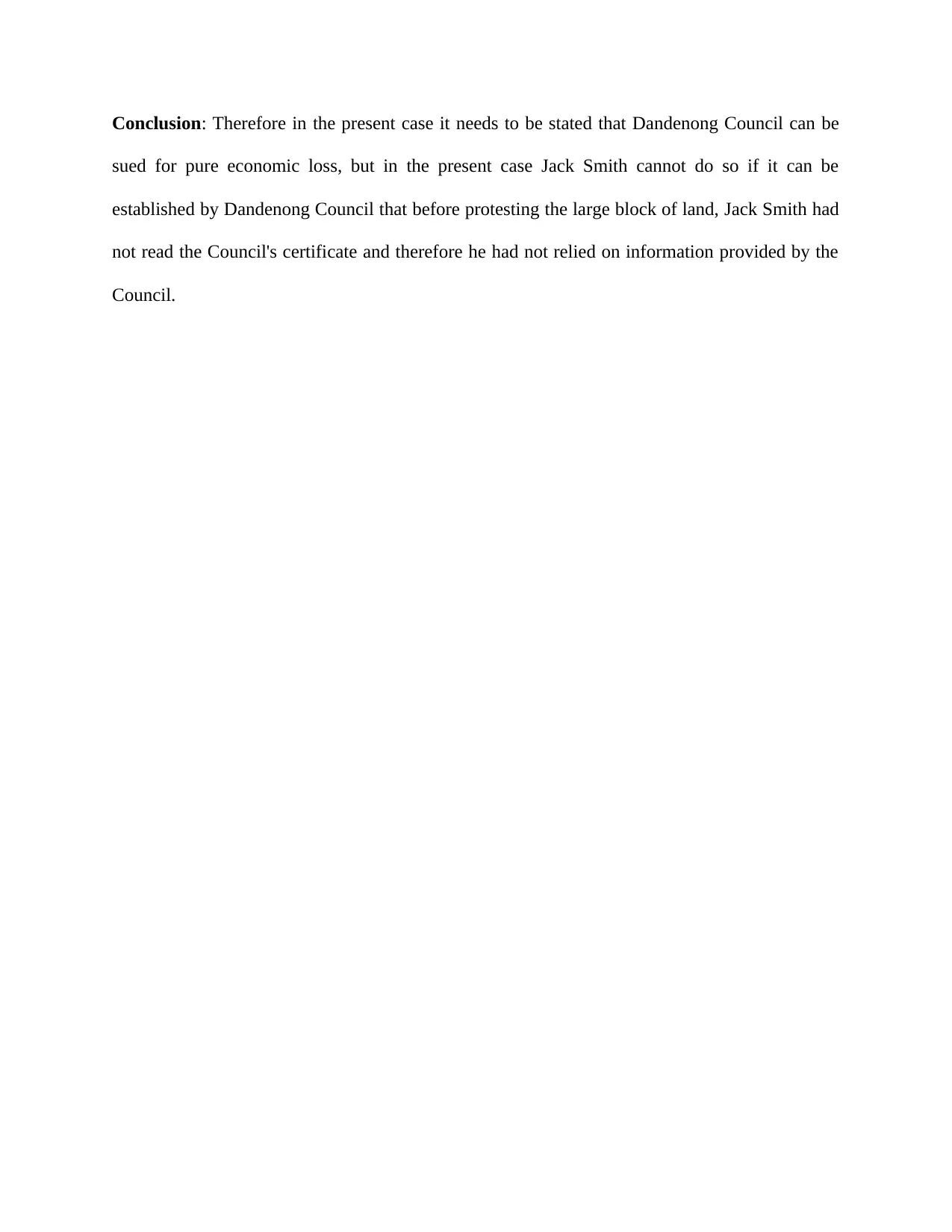
Conclusion: Therefore in the present case it needs to be stated that Dandenong Council can be
sued for pure economic loss, but in the present case Jack Smith cannot do so if it can be
established by Dandenong Council that before protesting the large block of land, Jack Smith had
not read the Council's certificate and therefore he had not relied on information provided by the
Council.
sued for pure economic loss, but in the present case Jack Smith cannot do so if it can be
established by Dandenong Council that before protesting the large block of land, Jack Smith had
not read the Council's certificate and therefore he had not relied on information provided by the
Council.
Paraphrase This Document
Need a fresh take? Get an instant paraphrase of this document with our AI Paraphraser
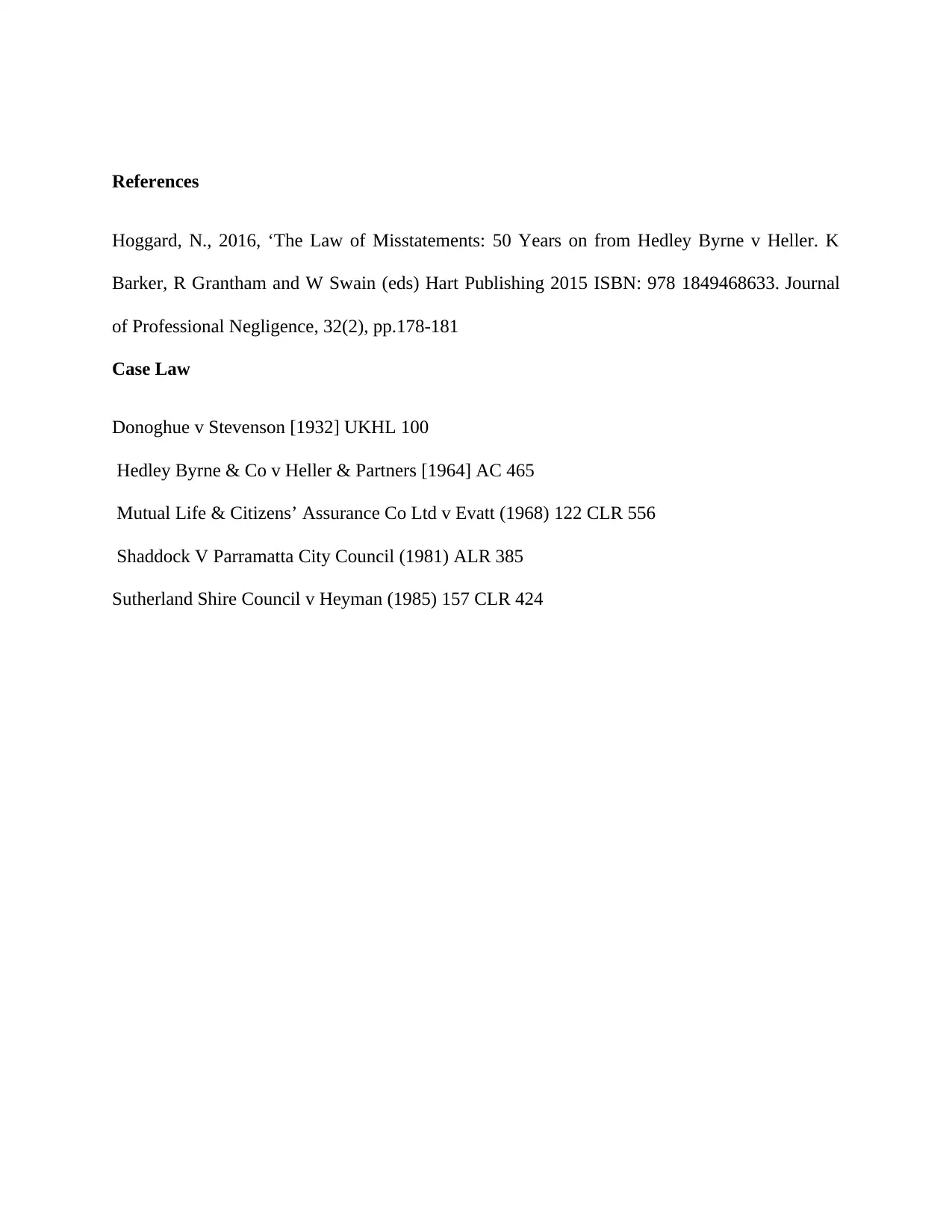
References
Hoggard, N., 2016, ‘The Law of Misstatements: 50 Years on from Hedley Byrne v Heller. K
Barker, R Grantham and W Swain (eds) Hart Publishing 2015 ISBN: 978 1849468633. Journal
of Professional Negligence, 32(2), pp.178-181
Case Law
Donoghue v Stevenson [1932] UKHL 100
Hedley Byrne & Co v Heller & Partners [1964] AC 465
Mutual Life & Citizens’ Assurance Co Ltd v Evatt (1968) 122 CLR 556
Shaddock V Parramatta City Council (1981) ALR 385
Sutherland Shire Council v Heyman (1985) 157 CLR 424
Hoggard, N., 2016, ‘The Law of Misstatements: 50 Years on from Hedley Byrne v Heller. K
Barker, R Grantham and W Swain (eds) Hart Publishing 2015 ISBN: 978 1849468633. Journal
of Professional Negligence, 32(2), pp.178-181
Case Law
Donoghue v Stevenson [1932] UKHL 100
Hedley Byrne & Co v Heller & Partners [1964] AC 465
Mutual Life & Citizens’ Assurance Co Ltd v Evatt (1968) 122 CLR 556
Shaddock V Parramatta City Council (1981) ALR 385
Sutherland Shire Council v Heyman (1985) 157 CLR 424
1 out of 5
Related Documents
Your All-in-One AI-Powered Toolkit for Academic Success.
+13062052269
info@desklib.com
Available 24*7 on WhatsApp / Email
![[object Object]](/_next/static/media/star-bottom.7253800d.svg)
Unlock your academic potential
Copyright © 2020–2025 A2Z Services. All Rights Reserved. Developed and managed by ZUCOL.





